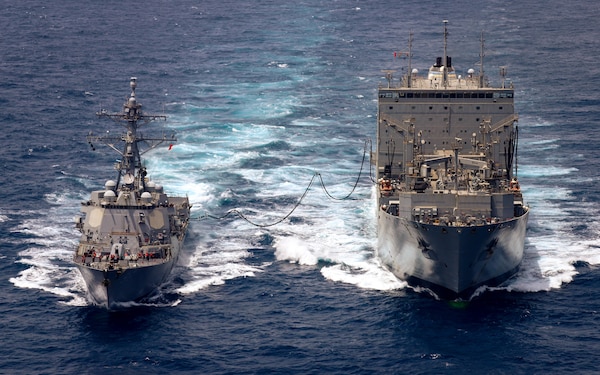“We're an empire now, and when we act, we create our own reality.”--attributed(link is external) to an unnamed official in the administration of President George W. Bush (alleged to be Karl Rove)
The US preaches to the world the necessity of maintaining the ‘international order’ that it helped build, defends and from which it asymmetrically benefits. Yet it alone among maritime powers refuses to ratify the foundation of international order at sea--the UN Convention on the Law of the Sea (UNCLOS). Compounding its hypocrisy, it continues to unilaterally interpret some of the Convention’s key provisions to its advantage. Examples include terms relevant to freedom of navigation like “other internationally lawful uses of the sea”, “marine scientific research”, “abuse of rights”, “due regard” and “peaceful use/purpose”. Even worse, it then backs up its interpretations with threat of use of force aka Freedom of Navigation Operations (FONOPs).
Now the US Naval War College—in coordination with the US Navy, Marine Corps and Coast Guard--has unilaterally defined more controversial naval legal terms to its advantage and incorporated them in the latest edition of The Commander’s Handbook on the Law of Naval Operations [the Handbook]. These ‘revisions’ are summarized(link is external) by Cynthia J. Parmley(link is external) and Raul (Pete) Pedrozo(link is external). They include the law governing unmanned systems, autonomous systems, information warfare, cyber operations and outer space. In the authors’ own words this Handbook” has been influential in advancing maritime security law and the law of naval warfare around the world”. Although “not a comprehensive treatment of the law”, it is nevertheless yet another attempt to unilaterally make international law.
Regarding cyberspace operations, the Handbook “clarifies that cyberspace operations may rise to the level of a use of force within the meaning of the UN Charter if their ‘scale and effects’ are analogous to other kinetic and non-kinetic operations that are tantamount to a use of force”. In doing so, in the authors’ own words, “the Handbook rejects the International Court of Justice’s assertion in its Paramilitary Activities(link is external) judgment that only the “most grave” uses of force qualify as armed attacks.” This lowers the threshold for the “right to take necessary and proportionate force in self-defense.” A change that significant should have been negotiated with other maritime powers.

Case Concerning Military and Paramilitary Activities in and against Nicaragua, Judgment of 27 June 1986
The 1967 Outer Space Treaty requires that the moon and other celestial bodies shall be used exclusively for “peaceful purposes” (Article IV)(link is external). But the Handbook defines “peaceful purposes” as permitting “defense and intelligence activities” and states that “the U.S. will continue to use space for national security”.
This ambiguous interpretation of peaceful purposes also applies to US uses of the oceans. But there it raises other questions. When and how are deployments of offensive weapons like carrier strike groups in another country’s EEZ or FONOPs a threat of use of force and thus not “peaceful purposes/uses”? How about cyber attacks or deliberately provocative electronic warfare activities originating from the EEZ? The authors assert that cyber attacks are a use of force “if their ‘scale and effects’ are analogous to other kinetic and non-kinetic operations that are tantamount to a use of force”. What is good for the goose should be good for the gander.
The most egregious example of attempting to unilaterally make international law involves the status of maritime drones—unmanned surface and underwater vehicles (USVs and UUVs). The Handbook seeks to have them included under the definition of ‘warship’ which has ‘sovereign immunity’.
A warship is defined in UNCLOS as a “ship belonging to the armed forces of a State bearing the external marks distinguishing such ships of its nationality, under the command of an officer duly commissioned by the government of the State and whose name appears in the appropriate service list or its equivalent, and manned by a crew which is under regular armed forces discipline (Article 29(link is external)).
In an attempt to apply this definition to drones, the Handbook states that “if a USV or UUV will engage in hostilities, it must first be designated as a warship or it must be launched from a warship so that it can engage in belligerent acts as an extension of the warship”. It also asserts that the “manning” can be remote. Thus according to the Handbook, “USVs or UUVs do not need to have a crew or commanding officer physically onboard to be designated a warship.”
Despite the unnamed Bush administration official’s assertion, declaring that a drone is a warship does not necessarily make it so. As the saying goes, you can put lipstick on a pig but it is still a pig.
According to UNCLOS Article 32, whether or not a drone has sovereign immunity depends on whether it is a “warship or a government ship operated for noncommercial purposes.” But is a drone a ‘vessel’ or a ‘ship’ ? The terms vessel and ship are frequently used but not defined in UNCLOS.
Some US Navy lawyers argue(link is external) that a variety of treaties define ‘vessel’ sufficiently broadly to include “autonomous and even expendable marine instruments and devices”. They cite the Treaty on International Regulations for Preventing Collisions at Sea which defines ‘vessel’ as “every description of water craft used as a means of transportation on water. Thus it must be transporting something—in this context presumably humans. The word vessel(link is external) means “every description of watercraft or other artificial contrivance used, or capable of being used, as a means of transportation on water”. Transport means(link is external) “to take or carry (people or goods) from one place to another”. Most US Navy drones are obviously not used as a means of transportation on water.
The Handbook states that “a USV or UUV may exercise the same navigational rights and freedoms and other internationally lawful uses of the seas related to those freedoms as manned ships”. But it must operate within the law. Under UNCLOS the EEZ has some restrictions on freedom of navigation which apply to drones. For example, marine scientific research can only be undertaken in a country’s EEZ with its permission. So the question then becomes “‘is the drone undertaking ‘marine scientific research’ in a coastal country’s EEZ”? If so it requires the prior consent of the coastal state. Navy lawyers will likely argue that it is undertaking hydrographic or military surveys that do not require the permission of the coastal state. But this controversy can be put to rest by a plain reading of UNCLOS Article 258. It provides that “the deployment and use of any type of scientific research installation or equipment in any area of the marine environment shall be subject to the same conditions as are prescribed in this Convention for the conduct of marine scientific research in any such area.”
Moreover, foreign vessels including drones exercising their rights in a country’s EEZ must have “due regard” for the rights and duties of the coastal state as well as for the interests of other states exercising their high seas freedoms.
In sum, despite US attempts to unilaterally assert international law, the activities of drones are still a legal “grey area”. Relevant questions are:
- whether the “sovereign immunity” clause extends to drones deployed from but not controlled by state vessels and if so under what conditions?;
- does it apply to “non-ratifiers” of UNCLOS like the U.S.?;
- if a warship deploys a drone in the vicinity of another vessel does this violate theduty to exercise “due regard” for the rights of other states, like the duty not to present a hazard to navigation?; and
- if a drone is being used for ‘military’ or hydrographic research under the guise of ‘scientific’ research is this an abuse of rights --which is a violation of UNCLOS?
The U.S. is setting a dangerous example by unilaterally asserting and implementing its interpretations of terms in a treaty it has not ratified. If many coastal states enact unilateral national legislation prohibiting certain military and intelligence gathering activities by drones in and above their jurisdictional zones, then the prohibition against conducting such missions could become part of customary international law through state practice, despite the opposition of a few countries like the U.S. and its allies.

The U.S. should negotiate with other states--especially its rival maritime powers Russia and China--to reach broad agreement on the law covering the activities of drones over, on and under the sea. US attempts to unilaterally define the relevant international law will only exacerbate the situation and could come back to haunt it if and when the shoe is on the other foot.

